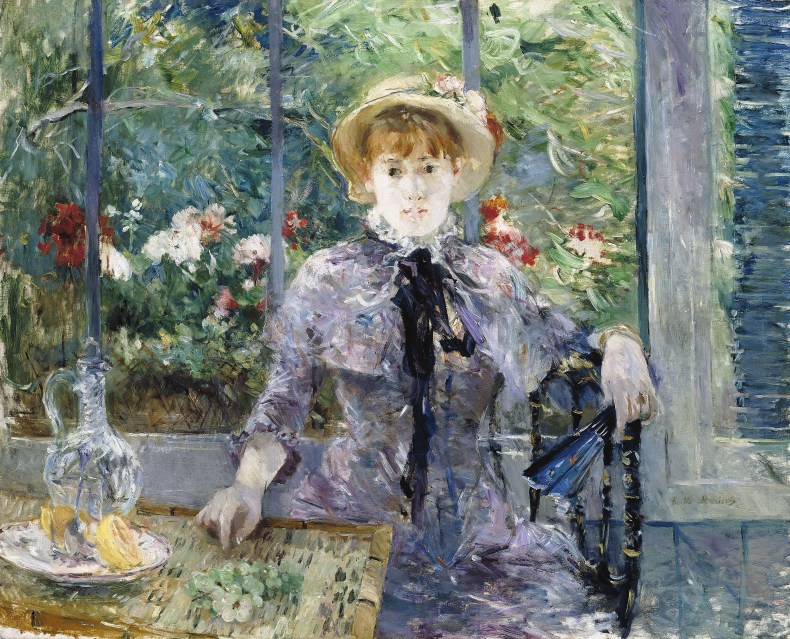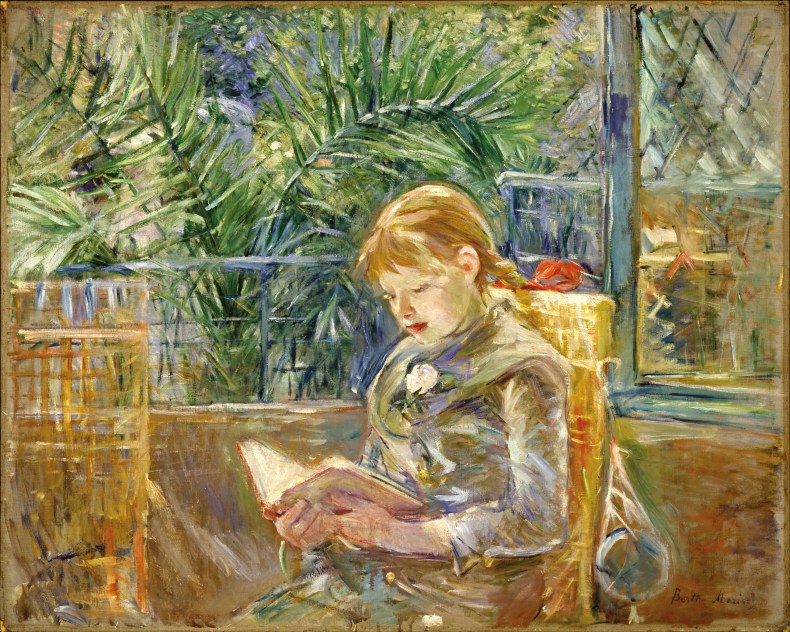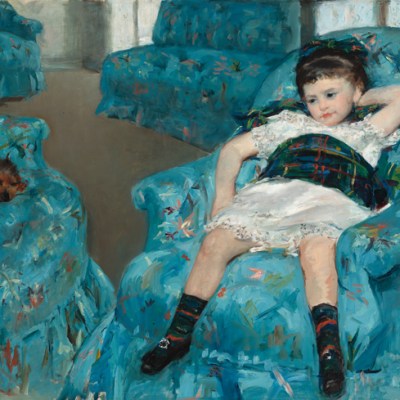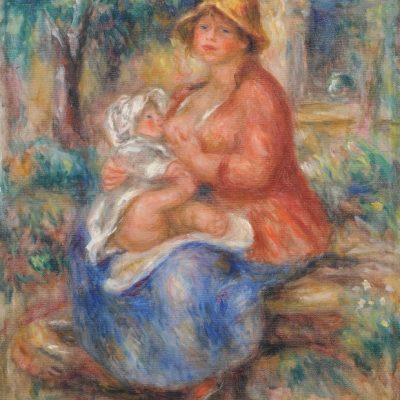In her lifetime, Berthe Morisot (1841–95) was considered by her close friends Renoir, Monet, and Degas to be as central as anyone to the Impressionist movement. She showed at seven of the historic Impressionist shows (only Pissarro showed at all eight) and left behind a relentlessly experimental body of work that develops next to Manet’s through the 1870s, blooms in the great garden paintings of the 1880s, and anticipates the next century by taking a turn toward inward-seeking Expressionism in the 1890s. When she died in 1895, Pissarro paid tribute in a letter to his son: ‘Still in Paris, because I want to attend the funeral of our old comrade Berthe Morisot, who died after an attack of influenza. You can hardly conceive how surprised we all were and how moved, too, by the disappearance of this distinguished woman, who had such a splendid feminine talent and who brought honour to our Impressionist group which is vanishing – like all things. Poor Madame Morisot, the public hardly knows her!’
The public was given few chances to know her in the century and more after her untimely death. Morisot was the greatest Impressionist painter whose works you had hardly seen, unless you went, 31 years ago, to the show organised by the National Gallery in Washington and Mount Holyoke College Art Museum in 1987. Signs of possible change came with the new millennium and exhibitions in regional France, Japan, Denmark, and Spain. In Paris, an exhibition at the Musée Marmottan Monet in 2012 was the first monographic show of her work in the city in more than 50 years. French curators credit feminist scholars in North America with helping to draw attention to Morisot over the decades, but she has hardly been prominent in North America, either. In her lifetime, Morisot paid attention to sales and shows; she was strategic about what subjects she painted; the most important collectors of the day bought her works. But she was also fairly well-off and did not need to sell in the way that Renoir and Monet had to. Dealers were slower to press a woman for shows or sales, and she died just as Impressionist works began to be more widely appreciated and collected. Perhaps Morisot would have had a more acknowledged influence on the next generations of painters if her works had been on view in the first decade of the 20th century, in the way that those of Cézanne and Monet were. Morisot wrote in her diary in 1890, ‘I don’t think there has ever been a man who treated a woman as an equal, and that’s all I would have asked for – I know I am worth as much as they are.’
Cottage Interior (1886), Berthe Morisot, Musée d’Ixelles, Brussels.

A year after her death, in 1896, Renoir, Monet and Degas hung a memorial show of nearly 400 works – still the largest Morisot exhibition that has ever taken place – and it included paintings that no curator has had access to since. Morisot’s descendants have cherished her paintings as both masterpieces and precious heirlooms; many of them are of her daughter Julie Manet, her niece Paule Gobillard, and other members of the family circle, including her husband, Eugène Manet, brother of Édouard. An astounding proportion of Morisot’s most important work is still in private hands. Significant paintings have not even been reproduced and, furthermore, the work reproduces so badly that on the page it sometimes seems not just diminished, but obliterated.
This year ‘Berthe Morisot: Woman Impressionist’, a landmark exhibition of some 60 or 70 works (depending on the venue), begins a journey from the Musée national des beaux-arts du Québec, continuing in the autumn to the Barnes Foundation (21 October–14 January 2019) and to the Dallas Museum of Art and the Musée d’Orsay in Paris next year. Its co-curators, Sylvie Patry of the Musée d’Orsay and the Barnes Foundation (where she is a consulting curator), and Nicole R. Myers from the Dallas Museum of Art, have worked closely with André Gilbert of the MNBAQ, where the idea of a Morisot show in North America first germinated. Gilbert tells me that the task was difficult, because the works are so scattered, but that collectors have been unusually willing to lend, feeling that the exhibition is, perhaps by many decades, overdue.
In England (Eugène Manet on the Isle of Wight) (1875), Berthe Morisot, Musée Marmottan Manet, Paris.

It is almost impossible to believe that these paintings have been overlooked. The qualifying statements people often make about their so-called domesticity and how Morisot did the best she could within a limited sphere, even when meant as a defence of the work, are entirely unconvincing: what is ‘the domestic’ but the core of life, of eros, and of work? The current show and its insightful catalogue argue for Morisot as a force to be reckoned with. Patry and Myers explain that they hoped the title of the exhibition would signal to museum-goers at least one of the reasons for Morisot’s obscurity. ‘We called it “Woman Impressionist”,’ Myers says, ‘but we hope it is for the last time.’
For three days in June I worked my way through the subtle installation of ‘Berthe Morisot: Woman Impressionist’ in Québec City, where the architecture of the museum’s striking new expansion situates Morisot for the next century. Each day, I sat in the intimate white rooms, the pictures thoughtfully grouped by both theme and chronology, with a few windows cut into the partition walls so that you can look back to earlier pictures and ahead to later ones. In Morisot’s paintings, windows are evocative settings for pensive figures. She was interested not only in seeing, but in seeing through – whether seeing through semi-transparent air, through paint, or a person, visually or psychologically.
In the Country (After Lunch) (1881), Berthe Morisot, Lawrence Ellison Private Collection. Photo: © Christie’s Images/Bridgeman Images

In the Country (After Lunch) (1881) shows a woman seated before what appear to be open panels; the garden is an almost Vuillard-like tapestry behind her. (Vuillard was an admirer of Morisot’s work.) The greens have depth, but also come forward, almost to join the flowers in the woman’s hat and to re-emerge in the grapes on the table before her. There is a translucent water pitcher with lemons (a nod to Chardin), and there is a clarity of rectangular composition, one rectangle laid as the table in the lower left corner, the other as the shutter of violet, blue, and green along the right-hand side. But when you stand before the painting what astonishes – and this is barely discernible in the reproduction even if you know what to look for – is that the lady vanishes. She is transparent to the garden behind her – you can see through her abdomen. The effect is at once spectral and glorious as the colours whirl about that forming centre. It is a painting that makes you pay attention to paint.
Many of the works in the show are similarly complex meditations on their own medium. In Night-time Toilette (1886), for example, a woman paints the face of a young girl with white lotion in preparation for sleep. Young Girl with a Vase (1889), which Morisot exhibited as finished, is almost as emphatic about drawing as a Giacometti painting, with the sketched lines of desk and chair coalescing from the corners of the canvas into a completely painted torso, head, and vase of flowers. Morisot’s use of white – in chiffon dresses, mirrors, ripples on lakes, squares of laundry, bed frames, cradle nets, vases, flowers, edges of instruments, and as diffusions in the sky, ground, water, light, and air – is spectacular. Both Night-time Toilette and Young Girl with a Vase are studies in white, and in materialisation. They are also, like many of the works in the show, whether of domestic workers or ball-goers, paintings that show women conceptualising their own lives as they watch the world and are themselves watched.
Young Girl with a Vase (1889), Berthe Morisot. Private collection. Photo: Studio Thierry Jacob

It is a part of the fertility of the Impressionist movement that the painters worked quite intimately next to one another, often in pairs, and were one another’s teachers. Although the styles of each artist are distinctive, their works stretch and reach toward one another, allowing them to make leaps that would have taken much longer had they worked in isolation. Morisot’s half in some of these pairings has received scant critical and curatorial attention and the result is that our understanding of Manet, Degas, Monet and Renoir has also been impoverished.
Morisot’s influence extended to important poets and composers of her day. One of her closest friends was the poet Mallarmé, with whom she shared a love of brevity, leaves, and music. The poet Paul Valéry, Morisot’s nephew by marriage, lived his adult life in what had been her house, surrounded by her paintings, wrote introductions for catalogues of her shows, and represented the continuing tradition of understanding among the descendants of that inner circle. Valéry remarked on similarities between the effect of Morisot’s canvases and that of Mallarmé’s poems. ‘Made up of nothing, they multiply that nothing, a suspicion of mist or of swans, with a supreme tactile art, the skill of a brush that scarcely feathers the surface. But that featheriness conveys all: the time, place, and season, the expertise and swiftness it brings, the great gift for seizing on the essential, for reducing matter to a minimum and thus giving the strongest possible impression of an act of mind.’
Morisot painted people she knew well, and she painted with them, too. Her first paintings were done in lessons she took with her sister Edma. By the time the pair came to work with Corot, their unusually supportive family understood the sisters were no ordinary amateurs. Edma gave up painting when she married, remaining one of her sister’s most frequent models; she thought Berthe right to continue painting and to hesitate about marriage. All of this, and much else, is present in the portrait of Edma with her new baby, The Cradle (1872), and Woman and Child on a Balcony (1871–72), a portrait of the other Morisot sister, Yves, with her daughter Paule Gobillard.
The Cradle (1872), Berthe Morisot, Musée d’Orsay, Paris. Photo: © Musée d’Orsay, Dist. RMN-Grand Palais/Patrice Schmidt

Édouard Manet, too, was a familiar figure, who frequented the Morisot parents’ successful evening salon. Morisot and Manet painted with each other in mind for several years; Manet painted 14 portraits of Morisot. (Among other things, they shared an interest in 18th-century painting. Nicole R. Myers points out in her catalogue essay that Morisot’s erudition, and her technical ability to bring forward the tradition of Fragonard and Watteau were admired by Manet, critics, collectors, and other painters.) Eugène Manet was also a painter, though not interested in showing; he refused Degas’s invitation to exhibit with the Impressionists in 1877. Morisot and Eugène Manet painted next to each other, he worked to make her shows go well, and their house was where Degas, Mallarmé and Renoir were to be found nearly every Thursday evening for decades.
Morisot’s most profound relationship with a model was with her daughter Julie Manet, whom she first painted in early babyhood with her wet nurse, through canvas after canvas of Julie in her childhood, sitting with her father or the nanny in the garden, looking out windows, playing the violin, up until a final portrait, when Julie was 16. The family atmosphere – a life lived among painters, through paint – is palpable in Julie’s girlhood diary, which chronicles the time just before and after Morisot’s death. Julie was often with Degas, who, despite his misanthropy, was a devoted friend, and Renoir and Mallarmé fulfilled Morisot’s trust in them and were excellent guardians. Morisot had been Julie’s painting teacher, too, and her daughter went on seeing the world through her eyes. A typical entry in her diary: ‘A number of boats, with sails which had become grey with age, went by and formed a lilac mass against the light.’ When she travelled, she knew that ‘every time I see a beautiful landscape I will think to myself: “How well Maman would have painted that!”’
In Québec City pride of place has been given to a number of unconventional works that Morisot chose to exhibit as finished, an understandable curatorial choice, but one that leaves several ambitious paintings in narrow spaces where it is hard to back up and get their full impact [the exhibition in Québec City closed on 23 September]. The exhibition more generally is focused around the challenges of figure painting, which slightly unbalances Morisot’s ideas of the relationship between figure and ground. She was a great landscape artist, and part of the living atmosphere of paintings like Woman and Children on the Lawn (The Lilacs at Maurecourt) (1874) or On the Lake (1889) comes from the way they situate ambiguous character studies within evocative open spaces. At the time of the 1869 Salon Morisot had noted of The Pink Dress by Frédéric Bazille: ‘He has found what we are all looking for: to place the figure outdoors.’
I would give a lot to sit in a room with the great green paintings of the 1880s all together – this would be The Fable (1883), Mr M.[anet] and his Daughter (1883), On the Veranda (1884), Reading (1888), Cottage Interior (1886), with In the Country (After Lunch), and a few other paintings from the garden at Bougival that are in the catalogue but will join the show after Québec. Since it is a room in a dream, I would also include the Art Institute of Chicago’s Woman in a Garden (1882/83).
When I speak to the painter Bill Scott, who co-curated the National Gallery of Washington exhibition, he mentions that he would love to see a show of Morisot and Monet’s landscape work, and of their gestural abstraction. I hope for other shows, too. A show about Morisot and Renoir would illuminate the late work of both artists, when they began to lay the groundwork for Expressionism.
Reading (1888), Berthe Morisot, Museum of Fine Arts, St Petersburg, Florida

Morisot’s late work and the arc of her career will always be obscured by her early death. Sylvie Patry says to me that she thinks at the end Morisot wanted ‘to detach herself from the immediacy of the quick impression’ to achieve a new ‘interiority’. The paintings become smaller and more enclosed, although there are still girls climbing ladders up into cherry trees. The final room in Québec City shows paintings Morisot made mourning the death of Eugène Manet. In these, Julie and her cousin and other young musicians with their pianos, violins and lutes, become condensed and symbolic figures. The feathery dashes of paint that had pulled figure and landscape together have become long, vertical, undulating brushstrokes that suggest instead the heights and depths of their subjects’ inner lives.
In this last room, trying to see past the last portrait of Julie in a white dress, I imagined further shows taking shape – a show on Expressionism with late Morisot and Edvard Munch; a show on the subject of women alone with works by Manet, Degas, Morisot, Toulouse-Lautrec, and Valadon. Another of Morisot with Vuillard, Bonnard, Matisse; interiors and exteriors…
In 1941, an exhibition of Morisot’s paintings was mounted in Paris on the centenary of her birth. The catalogue contained a brief essay by Paul Valéry, who wrote that he thought sufficient time had passed and ‘the qualities that she alone among the Impressionists possessed and which, besides, are of the rarest in painting, can now be appreciated.’ He was a little premature, but perhaps, nearly 80 years later, we are ready at last. I hope we do not have to wait another 80 years for ‘Berthe Morisot: Defining Impressionism’.
‘Berthe Morisot: Woman Impressionist’ is at the Barnes Foundation, Philadelphia, from 21 October–14 January 2019.
From the September 2018 issue of Apollo. Preview and subscribe here.


